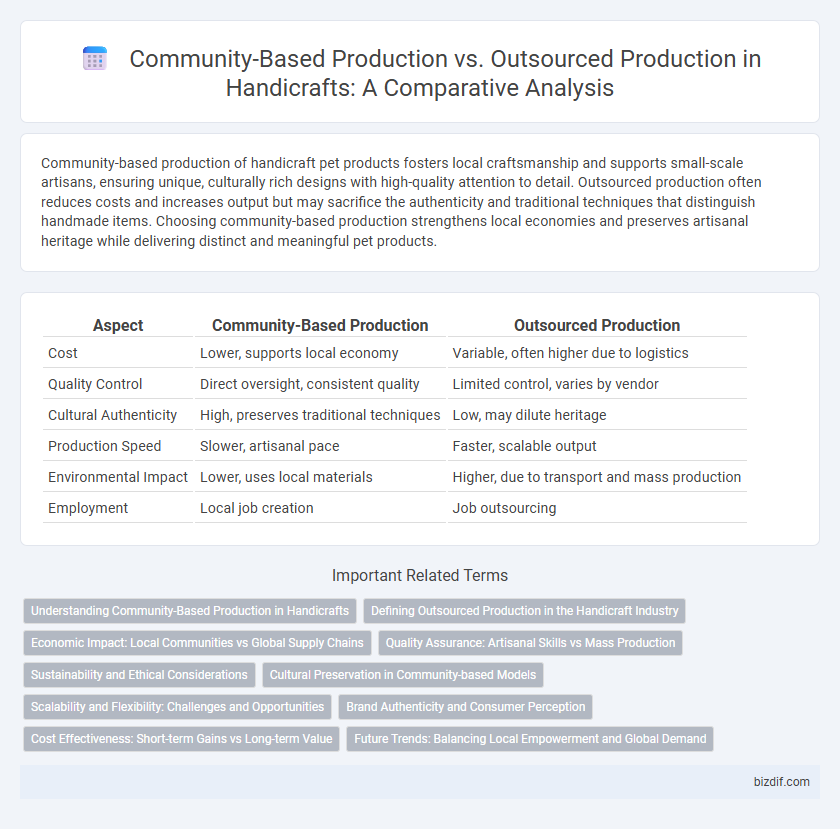Community-based production of handicraft pet products fosters local craftsmanship and supports small-scale artisans, ensuring unique, culturally rich designs with high-quality attention to detail. Outsourced production often reduces costs and increases output but may sacrifice the authenticity and traditional techniques that distinguish handmade items. Choosing community-based production strengthens local economies and preserves artisanal heritage while delivering distinct and meaningful pet products.
Table of Comparison
| Aspect | Community-Based Production | Outsourced Production |
|---|---|---|
| Cost | Lower, supports local economy | Variable, often higher due to logistics |
| Quality Control | Direct oversight, consistent quality | Limited control, varies by vendor |
| Cultural Authenticity | High, preserves traditional techniques | Low, may dilute heritage |
| Production Speed | Slower, artisanal pace | Faster, scalable output |
| Environmental Impact | Lower, uses local materials | Higher, due to transport and mass production |
| Employment | Local job creation | Job outsourcing |
Understanding Community-Based Production in Handicrafts
Community-based production in handicrafts emphasizes local artisanship, preserving cultural heritage while ensuring fair economic benefits for communities. This approach nurtures traditional skills, promotes sustainable practices, and strengthens social bonds within the community. By keeping production localized, it enhances the authenticity and uniqueness of handicraft products compared to mass-produced outsourced alternatives.
Defining Outsourced Production in the Handicraft Industry
Outsourced production in the handicraft industry involves contracting external manufacturers or workshops to produce handcrafted goods, often leveraging specialized skills or cost advantages. This approach contrasts with community-based production, where artisans within local communities create products, preserving traditional methods and cultural heritage. Outsourcing can increase scalability and reduce costs but may risk compromising authenticity and the socio-economic benefits to local artisans.
Economic Impact: Local Communities vs Global Supply Chains
Community-based handicraft production directly stimulates local economies by creating jobs, preserving cultural heritage, and encouraging sustainable practices, which often leads to greater income retention within the community. In contrast, outsourced production shifts economic benefits toward global supply chains, frequently resulting in reduced local employment and profit leakage from the community. Emphasizing community-based models supports economic resilience and cultural identity, while outsourced production prioritizes cost reduction and scalability over localized impact.
Quality Assurance: Artisanal Skills vs Mass Production
Community-based production ensures superior quality assurance through artisanal skills, preserving traditional craftsmanship and maintaining meticulous attention to detail in each handcrafted product. Outsourced production often prioritizes mass output, which can lead to variations in quality and compromise the authenticity of intricate designs. Emphasizing artisanal expertise safeguards the uniqueness and durability of handicrafts, enhancing consumer trust and satisfaction.
Sustainability and Ethical Considerations
Community-based production in handicrafts fosters sustainable practices by utilizing locally sourced materials and supporting artisan livelihoods, ensuring ethical labor conditions and preserving cultural heritage. Outsourced production often prioritizes cost-efficiency, which can lead to exploitation, environmental degradation, and loss of traditional craftsmanship. Emphasizing community-based models enhances transparency, reduces carbon footprints, and promotes fair trade principles within the handicraft industry.
Cultural Preservation in Community-based Models
Community-based handicraft production plays a vital role in cultural preservation by directly involving local artisans who possess traditional skills and ancestral knowledge. This model ensures authenticity in design and techniques, fostering the continuation of heritage crafts that are often lost in outsourced production. By sustaining local economies and empowering artisans, community-based production upholds cultural identity and promotes sustainable creative practices.
Scalability and Flexibility: Challenges and Opportunities
Community-based handicraft production offers unique scalability challenges due to reliance on local artisan skills and limited resources, which can hinder rapid growth yet foster highly customizable and authentic products. Outsourced production provides greater scalability benefits through access to larger manufacturing facilities and workforce flexibility, enabling mass production but often sacrificing intricate craftsmanship and local cultural elements. Balancing these models presents opportunities to blend scalable efficiency with the flexibility of personalized, community-rooted designs, enhancing market reach without diluting artisanal value.
Brand Authenticity and Consumer Perception
Community-based production in handicrafts strengthens brand authenticity by emphasizing traditional techniques and local artisan involvement, fostering genuine cultural connection that resonates with consumers. Outsourced production often risks diluting this authenticity due to standardized manufacturing processes and limited artisan input, potentially leading to consumer skepticism about product origin and quality. Consumers increasingly prioritize brands that showcase transparent community engagement and ethical craftsmanship, influencing purchasing decisions and brand loyalty.
Cost Effectiveness: Short-term Gains vs Long-term Value
Community-based production in handicrafts often incurs higher initial costs due to local labor and material sourcing but fosters long-term value through skill preservation, cultural authenticity, and sustainable economic impact. Outsourced production offers short-term cost savings by leveraging cheaper labor and mass production efficiencies, yet risks quality dilution and loss of artisanal heritage. Evaluating cost effectiveness requires balancing immediate financial gains against enduring benefits of craftsmanship integrity and community empowerment.
Future Trends: Balancing Local Empowerment and Global Demand
Community-based handicraft production fosters local empowerment by preserving traditional skills and providing sustainable livelihoods, while outsourced production meets global demand through cost-efficiency and scalability. Future trends emphasize hybrid models integrating digital platforms to connect artisans with international markets, ensuring fair trade and cultural authenticity. Technology adoption, combined with consumer interest in ethical sourcing, drives a balance between maintaining community integrity and expanding global reach.
Community-based production vs Outsourced production Infographic

 bizdif.com
bizdif.com